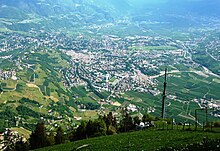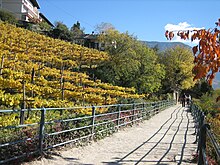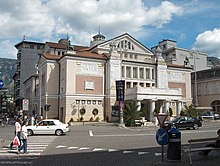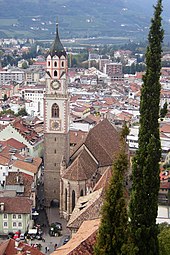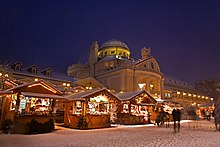Meran
| Meran | |
|---|---|
| (Italian Merano ) | |
| coat of arms | map |
| State : | Italy |
| Region : | Trentino-South Tyrol |
| Province : | Bolzano - South Tyrol |
| District community : | Burgrave Office |
|
Inhabitants : (VZ 2011 / 31.12.2019) |
37.436 / 41.170 |
|
Language groups : (according to 2011 census ) |
50.47% German 49.06% Italian 0.47% Ladin |
| Coordinates | 46 ° 40 ′ N , 11 ° 10 ′ E |
| Altitude : | 263– 1621 m slm (center: 325 m slm ) |
| Surface: | 26.3 km² |
| Permanent settlement area: | 15.6 km² |
| Parliamentary groups : | According to the municipal statute , Merano is not divided into fractions, the districts are: Sinich , Untermais , Obermais , Gratsch , Labers |
| Neighboring municipalities: | Algund , Burgstall , Avelengo , Lana , Marling , Schenna , Tyrol , Tscherms , Verano |
| Partnership with : | Salzburg |
| Postal code : | 39012 |
| Area code : | 0473 |
| ISTAT number: | 021051 |
| Tax number: | 00394920219 |
| Mayor (2015): | Paul Rösch ( Verdi Grüne Vërc / List Paul Rösch) |
Meran ([ meˈraˑn ]; Italian Merano , Ladin Maran ) is, after the provincial capital Bozen , with 41,170 inhabitants (as of December 31, 2019) the second largest city in the Italian province of South Tyrol . Its population is made up of roughly half each German and Italian speaking residents.
For centuries Merano was the Tyrolean capital. Since the middle of the 19th century, the city has been known primarily as a health resort .
geography
location
Meran is located in the Burggrafenamt in the Adige Valley . The municipality occupies a large part of the wide Merano valley basin, into which the Vinschgau valley from the west, Passeier from the north and Ulten from the south-west flow. Framed the valley is on the north side of the Oetztal Alps calculated Texelgruppe , east side of the Sarntal Alps and in the southwestern foothills of the Ortler Alps .
Urban area
The urban area extends to the north and east of the valley basin. The Passer flows through it , which is why Merano is also called the “Passerstadt”. The western border to Marling , Tscherms and Lana follows the Adige . The north-western neighboring municipality, which has grown together with Merano, is Algund . On the north side, the municipal boundary to Tirolo runs along the slopes of the Küchelberg and along the Passer at the entrance to the Passeier Valley. In the northeast, Merano borders on Schenna , in the southeast, where the municipality on the Tschögglberg reaches far more than 1000 m in places , on Avelengo and Verano , and in the south in the Adige Valley finally on Burgstall .
City structure
Merano is divided into several districts. The "real" Merano with the old town is at an altitude of 325 m on the orographic right side of the Passer ; Upper maize and lower maize are opposite on the left bank of the river. Gratsch and Labers are rural districts: Gratsch occupies the extreme north-west of the urban area at the foot of the Texel Group , while Labers extends over the slopes of the Tschögglberg in the east. Sinich with its industrial and commercial area is spatially separated from the rest of the city in the south.
Obermais, Untermais and Gratsch were independent communities until December 1923. As in Bolzano , there is no administrative division into parliamentary groups . A former district of Merano is Avelengo . From April 23, 1931 until Regional Law No. 7 of May 18, 1957, this now independent neighboring municipality was part of Merano.
climate
The climate of Merano is Mediterranean. The valley basin is well protected from precipitation and cold winds by the Texel Group in the north and north-west. The valley, which is open to the south, ensures the supply of balanced warm air (also in late autumn and spring), which encourages the growth of Mediterranean plants such as B. palm trees , cypresses , holm oaks , laurel , myrtle and Lebanon cedar is favored.
The weather is characterized by dry winters and wet summers.
|
Monthly average temperatures and precipitation for Gratsch (Merano)
|
|||||||||||||||||||||||||||||||||||||||||||||||||||||||||||||||||||||||||||||||||||||||||||||||||||||||||||||||||||||||||||||||||||||||||||||||||||||||||||||||||||||||||||||||||||||||||||||||||||
history
Around and in the area of today's Zenoberg , which joins Merano to the north-northeast, there are finds of human settlement from the Latène period and the Roman Empire. The Roman customs station statio Maiensis was opposite in the area of today's Obermais . There was in the 5th / 6th In the 19th century, it was believed to be a fortified late Roman settlement called Castrum Maiense .
Meran itself was first mentioned as Mairania in 857 at the latest . By the 12th century at the latest, Merano became the center of the County of Tyrol . Until 1420 (formally until 1848) the capital of the county, Merano was walled in 1280 as a market settlement founded by the Counts of Tyrol in the first half of the 13th century, and in the 14th century (1317 document in the Merano city archive) it became a city with an elected council, own seal and legal right to. At the end of the 14th century, Meran was founded by Leopold III. endowed with numerous sovereign privileges to promote trade.
The first documented citizens are the names Dietricus Satellarius and his brother Rappotus , as well as Chonradus Chemptarius , Heinricus Pibenanzus and Seivridus (Dietrich and Rapot Sattler, Konrad Kempter, Heinrich Pibenanz and Siegfried) attested from the year 1249 . Since the 14th century a prince's land and city judge has resided in Merano, and since the 15th century - together with the so-called waiter , the Habsburg economic official - in the prince's castle built by Duke Sigmund . Many of these judges came from abroad, for example a judge Heinrich von München ( Hainricus de Monaco iudex ) held office in 1378 . The notary's office in Merano was important in the 14th and 15th centuries ; Among the numerous notaries, Leonhard Vent (also: Vend) stands out, who was in office in the period 1447–1478 and left 18 notaries' registers, as well as temporarily holding the mayor's office.
The famous minstrel Oswald von Wolkenstein , who was visiting there, died in the Prince's Castle in 1445 .
With the move of the sovereign Friedrich "with the empty pocket" to Innsbruck in 1420 and the rise of the Brenner Pass to the most important trade route over the Eastern Alps as a result of the construction of the Kuntersweg , Merano quickly lost its primacy and its importance as an economic center. The relocation of the sovereign mint by his successor, Duke Sigmund, to Hall im Inntal around 1475 weakened Meran's position.
It was not until the Tyrolean struggles for freedom of 1809 that Merano returned to the center of attention: On the Küchelberg above Merano, the Tyroleans won a victory over the French and Bavaria .
In 1844, the Austrian noble family of the Counts of Meran, Barons of Brandhofen , a subsidiary line of the Habsburgs, with whom the morganatic marriage of Archduke Johann of Austria with the postman's daughter Anna Plochl was subsequently legitimized.
In 1855 Meran became a health resort, aristocrats and the upscale town tower came in increasing numbers. In 1914 40,100 guests were counted.
After the First World War , South Tyrol and with it Merano became part of Italy . However, in contrast to the new provincial capital Bolzano , the city largely escaped the assimilation and majorization policies of the fascist regime in Rome. This happened especially under the mayor Josef Gemaßmer (* 1874), who headed the city from 1914 to 1922, and his deputy mayor Karl Bär , who took over the business of the mayor from 1919 to 1922 as vice mayor. The skilful negotiations of the city administration under Mayor Max Markart (1922–1935) also contributed to a large degree of independence.
During the Second World War , Merano served as a hospital town , which spared it from being bombed. A particularly cruel fate befell the Jewish community of Merano , which was subjected to arbitrary harassment and deportations to extermination camps after the National Socialist occupation of the country on September 8, 1943 . A memorial in the courtyard at Otto-Huber-Straße 36 and the stumbling blocks that were moved from 2012 onwards commemorate the Jews who were deported to Germany in September 1943 .
Between 1945 and 1947 there were up to 15,000 Holocaust survivors in Merano .
Meran has a tradition as a spa and tourist resort and is considered one of the first tourist strongholds of the Habsburg Empire with many well-known guests from politics and culture . Scientists and doctors particularly valued the mild, Mediterranean climate and the clean air of the spa town, which was particularly beneficial for the healing of lung diseases. The daily spa concert was part of the healing program . There was a spa orchestra since 1855, later the spa orchestra , which usually gave concerts twice a day during the season. The orchestra was one of the most renowned in the Habsburg Empire and lasted until 2005. Even today, classical and other concerts with often internationally known musicians take place regularly in Merano, also daily between August and September.
After a significant decline in importance during the Second World War, these concerts, among other things, succeeded in making Merano one of the most important tourist destinations in South Tyrol after 1945.
The final battle and the final of the Candidates' tournament of the 1981 World Chess Championship were held in Merano.
population
| year | population | Language groups | ||
|---|---|---|---|---|
| German | Italian | Ladin | ||
| 1900 | 9.323 | 94.18% | 4.91% | - |
| 1951 | 27,908 | - | - | - |
| 1961 | 30,614 | - | - | - |
| 1971 | 33,235 | 45.00% | 54.72% | 0.28% |
| 1981 | 33,711 | 49.68% | 49.84% | 0.48% |
| 1991 | 33.504 | 50.46% | 49.01% | 0.53% |
| 2001 | 33,656 | 51.50% | 48.01% | 0.49% |
| 2011 | 37,368 | 50.47% | 49.06% | 0.47% |
politics
The last municipal council election on May 10, 2015 resulted in the following election result and the following distribution of seats in the municipal council of the city of Merano:
Mayor from 1800:
- 1797–1806: Johann August Genal
- 1806–1807: Josef Knoll
- 1807–1824: Josef Paul Buchmair
- 1824–1861: Josef Valentin Haller
- 1861–1870: Dr. Gottlieb Putz
- 1870–1873: Franz Putz
- 1873–1875: Simon Thalguter
- 1875–1879: Dr. Adalbert von Hellrigl
- 1879–1884: again Simon Thalguter
- 1884–1890: Dr. Josef von Pircher
- 1890–1914: Dr. Roman Weinberger
- 1914–1919: Josef Gemaßmer
- 1919–1922: Vice Mayor Dr. Karl Bear
- 1922–1935: Dr. Max Markart
During the German occupation :
- 1943–1945: Karl Erckert
Mayor since 1952:
- 1952–1953: Italo Zanandrea
- 1953-1956: Michele Vinci
- 1956–1964: Luigi Bertagnolli
- 1964–1966: Luigi Ercole Volante
- 1966–1973: Aldo Balzarini
- 1973–1974: Ottokar Polasek
- 1975–1980: Franco Dorigoni
- 1980–1983: Franz Alber
- 1983–1985: Giancarlo Micheli
- 1985–1988: Franz Alber
- 1988–1990: Giuseppe Rossi
- 1990-1994: Armin Ganner
- 1994–1995: Claudia Chistè
- 1995-2005: Franz Alber
- 2005–2015: Günther Januth
- 2015– : Paul Rösch
Economy and Infrastructure
With 16,913 employees in 3,946 workplaces, Merano is the second largest employer in South Tyrol after Bolzano. Three companies in the city each employ over 250 people. An industrial and commercial area is also located in the city.
traffic
Merano is connected to the Brenner autobahn (connection: Bozen-Süd) via an expressway, the so-called MeBo , and the city is also a junction for the roads to the Vinschgau , the Ultental , to Passeier and to the hilltop villages on both sides of the Adige Valley.
The Meran station links the Vinschgau Railway , which opened successfully again in 2005, and the Bolzano-Merano railway . In addition to the main train station, there is also the Meran-Untermais train station in the south of the city .
Several SASA city bus routes are used in inner-city traffic ; SAD regional buses run to the surrounding area . These transport services were previously provided by environmentally friendly trams and the local line Lana-Meran , the Merano tram opened in 1908 and discontinued in 1956.
In October 2013, the first part of the northwest bypass was completed, which runs underground from the MeBo (Merano-Bozen expressway) to the train station. The construction work for the second part of the bypass, which is to continue through the Küchelberg to the Zenoburg craftsmen zone, has not yet started (October 2013). The bypass is intended to relieve Merano of the through traffic to and from the Passeier Valley, which has previously been rolling through the city.
Merano is on the long-distance cycle path , which runs as the Via Claudia Augusta along an ancient Roman road of the same name .
education
Meran houses among others the country's hotel school imperial court and the Vocational School for the hospitality Savoy . Furthermore, there is in Merano, a technical secondary school for tourism and biotechnology with state specialist nutrition "Marie Curie" Meran (FOS), a Handelsoberschule (HOB) or economic Fachoberschule (WFO), the School of Business and Tourism (Lewit), the high schools Merano with Social science and humanistic educational offers , the Realgymnasium (RG / Wisslyz) with a focus on natural history and mathematics and the affiliated commercial college (GOB) or technical college (TFO) "Oskar von Miller", the Merano Waldorf School and the state vocational school "Luis Zuegg".
health
Merano is the location of a hospital of the South Tyrolean medical company .
Attractions

Historical buildings
- Parish Church of St. Nicholas with Barbara Chapel
- City parish church St. Vigil
- Spitalkirche - Holy Spirit Church
- Trauttmansdorff Castle with Botanical Garden
- synagogue
- Princely castle
- Katzenstein Castle and Fragsburg Castle in the south of Merano
- Ottoburg (Maiastraße 12, where Franz Kafka lived for a short time )
- Powder Tower (Ortenstein)
- City gates: Passeirer Tor, Bozner Tor, Vinschger Tor, Ultner Tor (demolished)
- Old town with Laubengasse
- City theater , built in Art Nouveau by Martin Dülfer in 1899
- Kurhaus
- Merano spa baths
- Kurpromenade (winter and summer promenade)
- Theater bridge
- Post Bridge
- Gilf with stone bridge
- Terrace at Tappeinerweg (remains of an explosives warehouse)
- Cemeteries in Merano
- Christ Church , planned by Johannes Vollmer in 1882 , partly furnished by Franz Xaver Pendl
Museums
- The Touriseum tourism museum was opened in the spring of 2003 and shows the historical development of tourism in South Tyrol.
- The privately run Women's Museum in Merano at Meinhardstraße 2 offers an insight into different epochs in the history of women.
- Merano Art / Merano arte in the house of the Sparkasse is a museum for contemporary art run by a non-profit association in the Merano arcades.
- The city museum is the oldest museum in South Tyrol. It reopened in April 2015 as the Palais Mamming Museum .
Surroundings of Merano
- Castle Tyrol , ancestral castle of the Counts of Tyrol with the South Tyrolean State Museum for Cultural and State History
- Zenoburg am Zenoberg (municipality of Tyrol)
- Site of Ötzi , the 5000 year old man from the ice in Schnalstal
Ski areas in the area
- Meran 2000 in Avelengo
- Schnalstal Glacier ski area in Schnalstal
- Schwemmalm ski area in Ultental
- Pfelders ski area in Passeier
- Ortler Skiarena Ski areas around Merano
Thermal baths and hotel
At the end of 2005, the new thermal baths opened in the heart of Merano in a park of more than 50,000 square meters, a cube made of stone, glass and steel with an interior design designed by Matteo Thun . Parts of the exterior architecture were used in the design of the hotel, which is also located in the park. The Hotel Therme Meran was partially financed by funds from the Province of South Tyrol (costs: approx. € 40 million) and opened in March 2006. From the opening until the end of September 2009, the hotel was operated by the Steigenberger Group. Since the beginning of October 2009, the hotel for sale has been run by Therme Meran AG. In July 2011 it was bought for € 30,601,000 from a bidding consortium consisting of Athesia and the Nestl, Demetz and Sanoner families.
The thermal water comes from a 2,350 m deep borehole in the Sinich district , has a temperature of approx. 90 ° C at its original depth (2,100 m - 2,300 m) and is heavily mineralized ( sulfate , chloride ). Furthermore, cool and slightly mineralized, but strontium and radon containing Merano mineral water from the Vigiljoch is added.
Racecourse
Meran has a large horse racing course . It is located in Untermais and has a 5 km long racetrack, on which the first race took place in 1935. The highlights of the season are the Haflinger gallop riding on Easter Monday and the Merano Grand Prix, a lavish obstacle race on the last Sunday in September.
Events
Merano Christmas
Christmas in Merano is one of the South Tyrolean Christmas markets.
Merano Music Weeks
Internationally most famous South Tyrolean music festival (South Tyrolean Classic Festival) with a focus on symphonic music from the classical and romantic periods. Since 1986 it has brought many of the most important European and non-European orchestras and soloists to Merano and thus tied in with the lively music scene in Merano in the heyday of the spa town (spa orchestra). It takes place between the end of August and the end of September with the main venues being the Kurhaus and City Theater.
MeranJazz Festival and Central European Jazz Academy
MeranJazz is a small, renowned jazz festival that has been taking place in July since 1997 and has been working closely with the Central European Jazz Academy since 2002. The program focuses on well-known American and Italian jazz musicians and ensembles. The Central European Jazz Academy conceptually connects the Italian and German-speaking cultural areas with changing teachers from the Italian and Central European region and also invites you to artist in residence .
Asphalt type
The three-day international street art festival has been held in June since 2006. It is one of the largest and most important festivals of its kind in Europe and has up to 25,000 visitors annually.
Personalities
Town twinning
- Salzburg (Austria)
See also
literature
- Otto von Reinsberg : Cultural-historical studies from Meran: language, literature, folk customs, guilds, with many unprinted documents. List / Francke, Leipzig 1874 ( digitized version )
- Cölestin Stampfer: History of Meran, the old capital of the state of Tyrol, from the oldest time to the present . Innsbruck 1889, Sendet Reprint 2009. ISBN 978-3-253-03039-0 . (2nd edition, Wagner, Bozen 1867, e-copy ).
- House plan of the spa town of Merano: List of streets, squares and promenades, villas, houses and farms in the spa district of Merano Meran: Pötzelberger 1922.
- Bruno Pokorny (Ed.): Meran, one hundred years of health resort 1836–1936. Festschrift of the old capital of the country for the centenary as a health resort . Innsbruck, University Publishing House Wagner 1936.
- Otto Stolz : Meran and the Burgraviato Office as part of the Tyrolean regional history (Schlern-Schriften 142). Innsbruck, Wagner University Press 1956.
- Elias Prieth: Contributions to the history of the city of Meran in the 16th century . Meran, Poetzelberger 1957.
- Franz-Heinz Hye : Meran / Merano . Austrian City Atlas, Delivery 3, Vienna 1988.
- Renate Abram: The Merano City Theater . Lana 1989.
- Gunther Langes : Burggrafenamt and Meran: the heart of Tyrol. (= South Tyrolean regional studies . Volume 4). 6th edition. Athesia, Bozen 1990, ISBN 88-7014-021-0 .
- Karl Moeser, Franz Huter (ed.): The oldest Tyrolean dictionary (Meran Regional Court 1468–1471) (Acta Tirolensia 5). Innsbruck, Universitätsverlag Wagner 1990. ISBN 3-7030-0219-0 .
- Katia Tatting: I borgomastri di Merano tra '400 e' 500. In: Geschichte und Region / Storia e regione 7, 1998, pp. 135–160.
- Ewald Kontschieder, Josef Lanz (Hrsg.): Meran and the artists (Italian: Artisti a Merano ). Bozen, Athesia 2001, ISBN 978-88-8266-115-1 .
- Franz Gratl: Meran. In: Oesterreichisches Musiklexikon . Online edition, Vienna 2002 ff., ISBN 3-7001-3077-5 ; Print edition: Volume 3, Verlag der Österreichischen Akademie der Wissenschaften, Vienna 2004, ISBN 3-7001-3045-7 .
- Paolo Valente : La città sul confine. Storie meranesi di uomini e fantasmi . Milano, Oge 2006.
- Alessandro Baccin: Discover Merano . Meran, Tangram Verlag 2007. ISBN 978-88-902852-0-2 .
- Paolo Valente: Merano. Breve storia della città sul confine . Bozen, Edition Raetia 2008.
- Renate Abram: Merano Symphony. 150 years of spa music . Bozen, Athesia 2009. ISBN 978-88-8266-578-4 .
- Hans H. Reimer: Lutheran in South Tyrol: History of the Evangelical Congregation Meran. A search for traces of Protestantism in South Tyrol and Trentino . Bozen, Edition Raetia 2009. ISBN 978-88-7283-332-2 .
- Anna Pixner-Pertoll: Built into the light: the Merano villas, their gardens and the development of the city (1860–1920) . Bozen, Edition Raetia 2009. ISBN 978-88-7283-355-1 .
- Gertraud Zeindl: Merano in the Middle Ages. A Tyrolean city as reflected in its taxes (Tiroler Wirtschaftsstudien 57). Innsbruck, Universitätsverlag Wagner 2009. ISBN 978-3-7030-0465-0 .
- Magdalene Schmidt, Walter Gadner: Squares Merans / Piazze di Merano . City of Merano, Merano 2011.
- Karl T. Kogler, Elfriede Hallama: Meran: K. uk Sehnsuchtsort in South Tyrol . Kral Verlag, Berndorf 2016, ISBN 978-3-99024-404-3 .
- Walter Gadner, Magdalene Schmidt: In a straight line - All'insegna della linea. Urban planning and architecture in Merano - Urbanistica ed architettura a Merano. Bolzano: Edition Raetia 2017. ISBN 978-88-7283-574-6
- Gustav Pfeifer (Ed.): 1317 - A city and its rights - Meran in the Middle Ages . Athesia, Bozen 2018, ISBN 978-88-6839-331-1 .
- Hans H. Reimer: They were strangers: 100 "Lutheran" pioneers of the world spa Merano in the 19th and 20th centuries. StudienVerlag, Innsbruck-Wien-Bozen 2019, ISBN 978-3-706559461 .
- Hitomi Sato, Hannes Obermair : Il notariato di Merano nel secondo Quattrocento. A proposito del progetto di ricerca "Political Societies in Medieval Alps: Mountain Towns and Surrounding Localities (Fostering Joint International Research)" . In: Studi di Storia Medioevale e di Diplomatica. Nuova series . tape 3 , 2019, p. 373-384 , doi : 10.17464 / 9788867743612 .
- Florian Pichler, Hermann Schnitzer (Hrsg.): Glücksfall Meran. Tourism and culture 1945–2020. Athesia-Tappeiner, Bozen 2020. ISBN 978-88-6839-477-6
Web links
- Website of the municipality of Merano
- Entry in the Tirol Atlas of the Institute for Geography at the University of Innsbruck
- Landscape plan of the municipality of Merano . Office for Landscape Ecology, Autonomous Province of Bolzano - South Tyrol (PDF file)
- The Curort Meran (1874)
- Cultural film by the Istituto Nazionale Luce: Merano from 1943 , camera: Piero Portalupi
Individual evidence
- ^ Municipal elections 2015 South Tyrol ( Memento from May 25, 2015 in the Internet Archive )
- ↑ Origin and history . Avelengo municipality. Retrieved September 12, 2015.
- ^ A b Paul Gleirscher : The Vinschgau in the early Middle Ages - Archaeological . In: Hans Rudolf Sennhauser , Katrin Roth-Rubi (ed.): Change and Constance between Lake Constance and Lombardy at the time of Charlemagne: St. Johann monastery in Müstair and Churrätien. Conference 13–16. June 2012 in Müstair (= Acta Müstair, St. Johann Monastery). vdf, Hochsch.-Verl. at the ETH, Zurich 2013, ISBN 978-3-7281-3583-4 , pp. 19–42, p. 26.
- ^ Paul Gleirscher: The Vinschgau in the early Middle Ages - Archaeological . In: Hans Rudolf Sennhauser, Katrin Roth-Rubi (ed.): Change and Constance between Lake Constance and Lombardy at the time of Charlemagne: St. Johann monastery in Müstair and Churrätien. Conference 13. – 16. June 2012 in Müstair (= Acta Müstair, St. Johann Monastery). vdf, Hochsch.-Verl. at the ETH, Zurich 2013, ISBN 978-3-7281-3583-4 , pp. 19–42, p. 25.
- ↑ a b Beda Weber : Meran and its surroundings. Or: The Burgrave Office of Tyrol - For locals and foreigners . Wagner'sche Buchhandlung, Innsbruck 1845, p. 6.
- ↑ Signature SAM UUR 8
- ↑ a b c d Franz Huter (Ed.), Hanns Bachmann: Handbook of historical sites . Band: Austria. Part 2: Alpine countries with South Tyrol (= Kröner's pocket edition . Volume 279). 2nd, revised edition. Kröner, Stuttgart 1978, ISBN 3-520-27902-9 , pp. 590-591.
- ^ Hannes Obermair : Bozen Süd - Bolzano Nord. Written form and documentary tradition of the city of Bozen up to 1500 . Vol. 1. Bozen: Stadtgemeinde Bozen 2005, ISBN 88-901870-0-X , p. 394.
- ^ Hitomi Sato, Hannes Obermair: Il notariato di Merano nel secondo Quattrocento. A proposito del progetto di ricerca "Political Societies in Medieval Alps: Mountain Towns and Surrounding Localities (Fostering Joint International Research)" . In: Studi di Storia Medioevale e di Diplomatica. Nuova series . tape 3 , 2019, p. 373-384, esp. 375 ff ., doi : 10.17464 / 9788867743612 .
- ^ Gunther Langes: Burggrafenamt and Meran. 2nd Edition. Bolzano: Athesia 1972, p. 103.
- ↑ The Sciliar . Vogelweider, 1999, p. 772 ( google.de [accessed on April 3, 2018]).
- ↑ Meraner Zeitung . No. 212 , December 31, 1923, p. 1 .
- ^ Sabine Mayr: The Annihilation of the Jewish Community of Meran . In: Georg Grote , Hannes Obermair (Ed.): A Land on the Threshold. South Tyrolean Transformations, 1915-2015 . Peter Lang, Oxford-Bern-New York 2017, ISBN 978-3-0343-2240-9 , pp. 53-75 .
- ↑ Bettina Spoerri: When the Alps became Aryan . In: Jüdische Allgemeine from August 2, 2007
- ^ Renate Abram: Merano Symphony. 150 years of spa music. Athesia 2009, p. 85ff
- ↑ 2015 municipal election in the municipality of Merano. Retrieved September 21, 2019 .
- ↑ Meraner Zeitung . No. 289 , December 31, 1923, pp. 77 . on-line
- ↑ The mayors of the South Tyrolean municipalities since 1952. (PDF; 15 MB) In: Festschrift 50 Years of the South Tyrolean Association of Municipalities 1954–2004. Association of South Tyrolean municipalities, pp. 139–159 , accessed on November 16, 2015 .
- ↑ http://www.provinz.bz.it/tiefbau/projektierung/701.asp#a5
- ^ New South Tyrolean daily newspaper: Fremde Federn , October 26, 2015
- ↑ Südtirol Online: Steigenberger gives up Hotel Therme Meran ( Memento from January 12, 2010 in the Internet Archive ), September 3, 2009
- ↑ Steigenberger leaves Meran . Allgemeine Hotel- und Gastronomie-Zeitung , September 2, 2009, accessed on April 23, 2019.
- ↑ Archived copy ( Memento of August 8, 2011 in the Internet Archive )
- ↑ First, second, sold - the Hotel Therme . Meraner Stadtanzeiger, July 15, 2011, p. 8, accessed on April 23, 2019.
- ↑ Autonomous Province of Bozen - South Tyrol: 31st Merano thermal fountain 1
- ↑ Merano thermal baths: thermal water
- ↑ Merano Music Weeks ( Memento from April 15, 2012 in the Internet Archive )
- ↑ www.meranojazz.it
- ↑ Type of asphalt in Merano! ( Memento from April 23, 2015 in the Internet Archive )
- ↑ Asfaltart ( Memento of 12 July 2014 Internet Archive ) Alto Adige from June 8, 2014
- ↑ Neue Südtiroler Tageszeitung from June 12, 2014, p. 16


